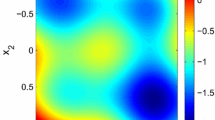Abstract
In the paper, we explain what subsets of the lattice ℤ n and what functions on the lattice ℤ n could be called convex. The basis of our theory is the following three main postulates of classical convex analysis: concave functions are closed under sums; they are also closed under convolutions; and the superdifferential of a concave function is nonempty at each point of the domain. Interesting (and even dual) classes of discrete concave functions arise if we require either the existence of superdifferentials and closeness under convolutions or the existence of superdifferentials and closeness under sums. The corresponding classes of convex sets are obtained as the affinity domains of such discretely concave functions. The classes of the first type are closed under (Minkowski) sums, and the classes of the second type are closed under intersections. In both classes, the separation theorem holds true. Unimodular sets play an important role in the classification of such classes. The so-called polymatroidal discretely concave functions, most interesting for applications, are related to the unimodular system \(\mathbb{A}_n : = \{ \pm e_i ,e_i - e_j \}\). Such functions naturally appear in mathematical economics, in Gelfand-Tzetlin patterns, play an important role for solution of the Horn problem, for describing submodule invariants over discrete valuation rings, and so on. Bibliography: 6 titles.
Similar content being viewed by others
REFERENCES
V. I. Danilov and G. A. Koshevoy, “Discrete convexity and unimodularity. I,” Adv. Math., 189, 301–324 (2004); http://arXiv.org/math.CO/0304291.
V. Danilov, G. Koshevoy, and K. Murota, “Discrete convexity and equilibria in economies with indivisible goods and money,” Math. Social Sci., 41, 251–273 (2001).
K. Murota, Discrete Convex Analysis, SIAM, Philadelphia (2003).
V. I. Danilov and G. A. Koshevoy, “Discrete convexity and nilpotent operators,” Izv. Ross. Akad. Nauk Ser. Mat., 67, 3–20 (2003).
V. I. Danilov and V. P. Grishukhin, “Maximal unimodular systems of vectors,” European J. Combin., 120, 509–526 (1999).
V. I. Danilov and G. A. Koshevoy, “Dicrete convexity and Hermitian operators,” Proc. Steklov Inst. Math., 241, 68–90 (2003).
Author information
Authors and Affiliations
Additional information
__________
Translated from Zapiski Nauchnykh Seminarov POMI, Vol. 312, 2004, pp. 86–93.
Rights and permissions
About this article
Cite this article
Danilov, V.I., Koshevoy, G.A. Discrete Convexity. J Math Sci 133, 1418–1421 (2006). https://doi.org/10.1007/s10958-006-0057-2
Received:
Issue Date:
DOI: https://doi.org/10.1007/s10958-006-0057-2



